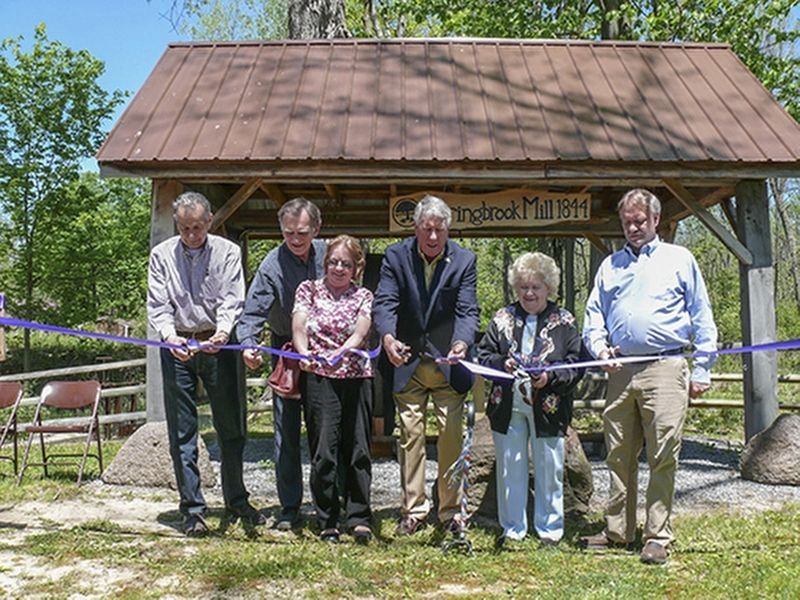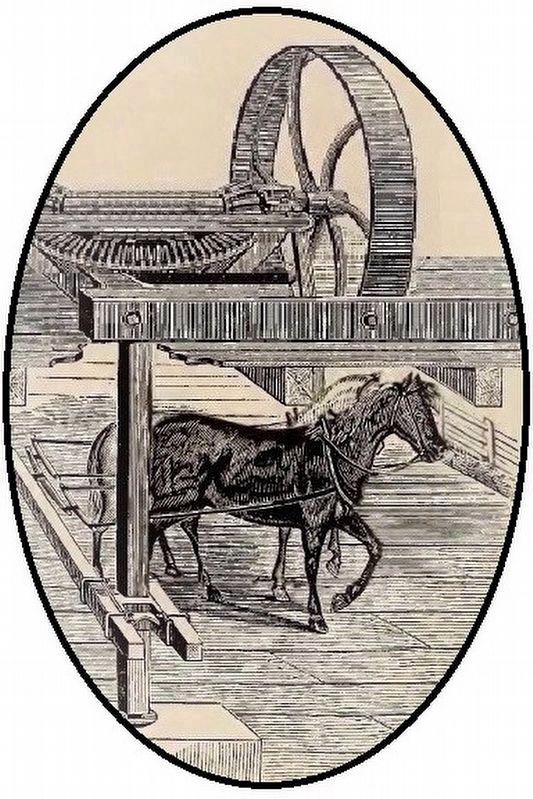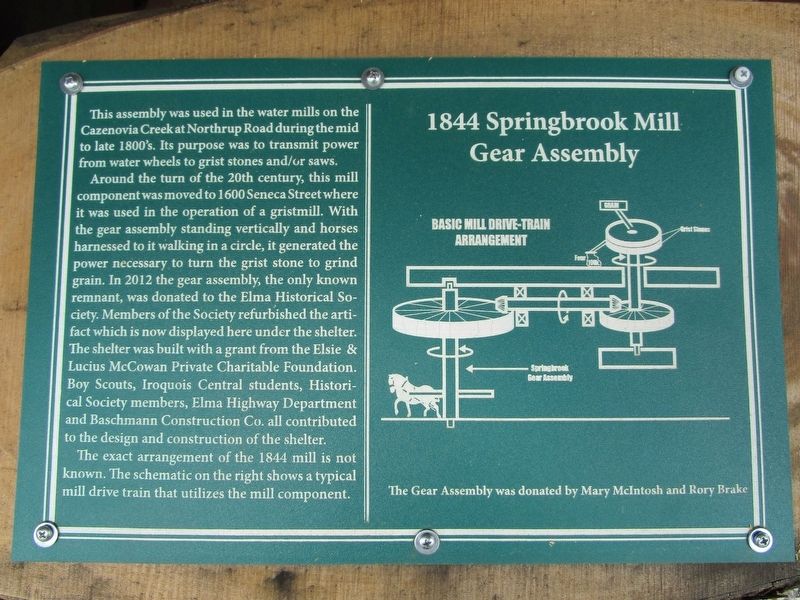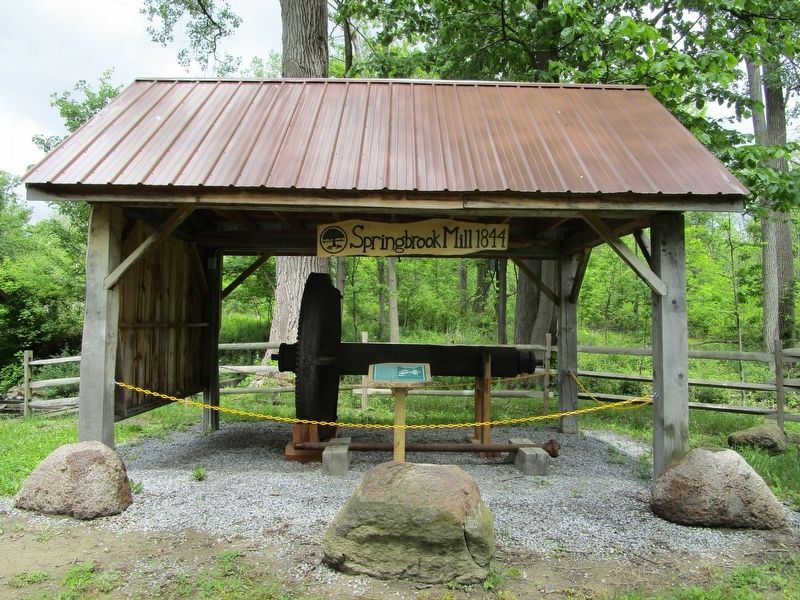Elma in Erie County, New York — The American Northeast (Mid-Atlantic)
1844 Springbrook Mill Gear Assembly
Basic Mill Drive-Train Arrangement
Around the turn of the 20th century, this mill component was moved to 1600 Seneca Street where it was used in the operation of a gristmill. With the gear assembly standing vertically and horses harnessed to it walking in a circle, it generated the power necessary to turn the grist stone to grind grain. In 2012 the gear assembly, the only known remnant, was donated to the Elma Hisrorical Society. Members of the Society refurbished the artifact which is now displayed here under the shelter. The shelter was built with a grant from the Elsie & Lucius McCowan Private Cheritable Foundation. Boy Scouts, Iroquois Central students, Historical Society members, Elma Highway Department and Baschmann Construction Co. all contributed to the design and construction of the shelter.
The exact arrangement of the 1844 mill is not known. The schematic on the right shows a typical mill drive that utilizes the mill component.
The Gear Assembly was donated by Mary McIntosh and Rory Brake.
Topics. This historical marker is listed in this topic list: Industry & Commerce. A significant historical year for this entry is 1600.
Location. 42° 51.065′ N, 78° 38.329′ W. Marker is in Elma, New York, in Erie County. Marker can be reached from Bowen Road, 0.1 miles north of Cemetery Road. Marker is on the grounds of the Elma Town Museum. Touch for map. Marker is at or near this postal address: 3011 Bowen Road, Elma NY 14059, United States of America. Touch for directions.
Other nearby markers. At least 8 other markers are within 4 miles of this marker, measured as the crow flies. Elma Village Mill (within shouting distance of this marker); Elma Town Museum (about 300 feet away, measured in a direct line); Big Flats (about 400 feet away); Elma Centre (approx. 1.7 miles away); Blossom (approx. 2.8 miles away); Spring Brook (approx. 3 miles away); Lewis Northrup (approx. 3 miles away); Our Men Who Made the Supreme Sacrifice (approx. 3.4 miles away). Touch for a list and map of all markers in Elma.
Related marker. Click here for another marker that is related to this marker. Lewis Northrup.

Photographed By Brian D. Szafranski, May 20, 2017
3. 2017 Ribbon Cutting for 1844 Springbrook Mill Gear & Axle Shelter
Left-to-right are: Frank Maciejewski, Elma Town Historian; Rory Brake & Mary McIntosh, donors of mill artifact; Denny Powers, Elma Supervisor; Marlene Baumgartner, Elma Historical Society President; and Tracy Petrocy, Councilman.

Photographed By Unknown, 1893
4. 1893 Catalog Image Showing Use Of A Similar Mill Gear And Axle Assembly.
This large mill gear and axle assembly is part of what is called a cider mill power.
When in use, the upright axle would have been turned by a water wheel or turbine, or by a horse or horses, on the lower level of the mill building. The axle's rotational power was sent up to the next level in the Mill to turn the large attached mill gear, which has straight-cut bevel gears set around the edge. Using other gears and belts & pulleys, this operated machinery in the mill.
Very few mills used this style of cider mill power, so it's a rare sight to see the major part of one still in existence. Don't miss out on seeing what may be the only surviving cider-mill-style mill gear and axle.
HISTORY LESSON ON POWERS: A power is also called a horse power (two words) or an animal power. Before steam engines became commonplace, powers were used to operate machinery, such as threshers, saws, feed cutters, and much more. Early horse powers could have horses walking in a circle, or walking on a treadmill (a.k.a. a railroad horse power). Powers continued to be used into the 1900s, even though steam and internal-combustion engines were essentially everywhere. Gin power was another name for this type of mechanism (although it may be a term more often used in England), as was upright power or vertical power.
Credits. This page was last revised on November 29, 2021. It was originally submitted on June 6, 2017, by Anton Schwarzmueller of Wilson, New York. This page has been viewed 279 times since then and 44 times this year. Photos: 1, 2. submitted on June 6, 2017, by Anton Schwarzmueller of Wilson, New York. 3, 4. submitted on November 27, 2021, by Brian D. Szafranski of Elma, New York.

